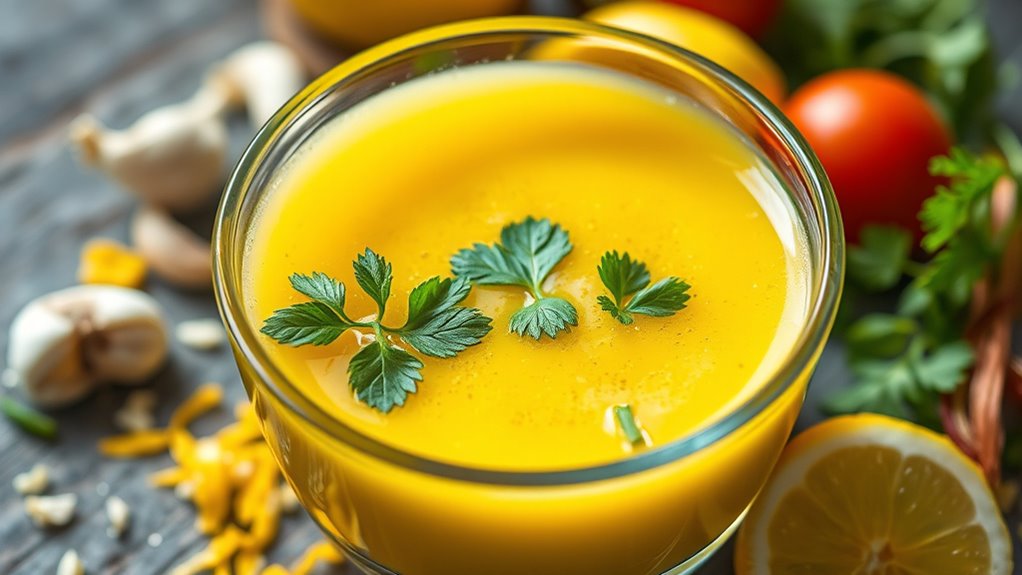Anti-inflammatory salad dressings use simple, whole-food ingredients you can trust, like extra-virgin olive oil or avocado oil, lemon juice or apple cider vinegar, and spices such as turmeric and cracked pepper. Start with a basic emulsion, whisking or shaking until smooth, then adjust with garlic or herbs to taste. Keep portions consistent—2–4 tbsp oil, 1–2 tbsp acid, 1 tsp herbs, 1/2 tsp spices—and refrigerate. If you want more, you’ll discover how to customize and optimize flavor and benefits.
Ingredients and Quantity
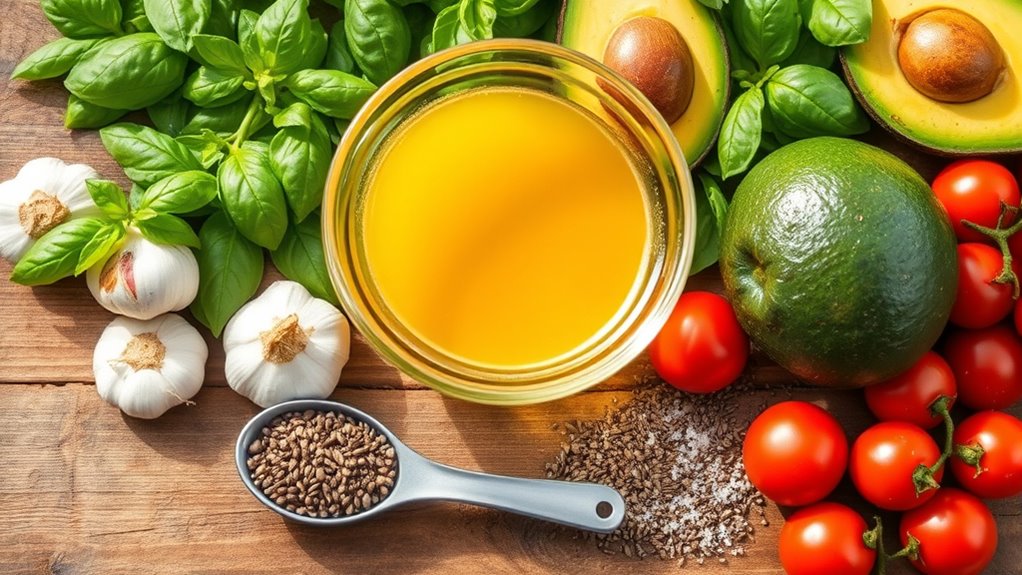
To make anti-inflammatory dressings, gather fresh, whole-food ingredients with simple, scalable quantities. You’ll pair healthy fats with bright, fresh herbs, ensuring balance and flavor without excess. Start with a base of extra-virgin olive oil or avocado oil, then add lemon juice or apple cider vinegar for brightness. Include anti-inflammatory spices like turmeric and cracked pepper, plus garlic or shallots for depth. Measure in easy portions: 2–4 tablespoons oil, 1–2 tablespoons acid, 1 teaspoon herbs, 1/2 teaspoon spices per serving. Use fresh herbs for aroma and nutrition. Aim for 4–6 pantry-friendly ingredients total, adjustable to taste. Healthy fats and fresh herbs anchor every dressing, supporting flavor, texture, and freedom in your meals.
| Ingredient | Quantity per serving | Notes |
|---|---|---|
| Oil | 2–4 tbsp | Base fat |
| Acid | 1–2 tbsp | Lemon juice or vinegar |
| Herbs/Spices | 1 tsp + | Fresh or dried |
Preparations
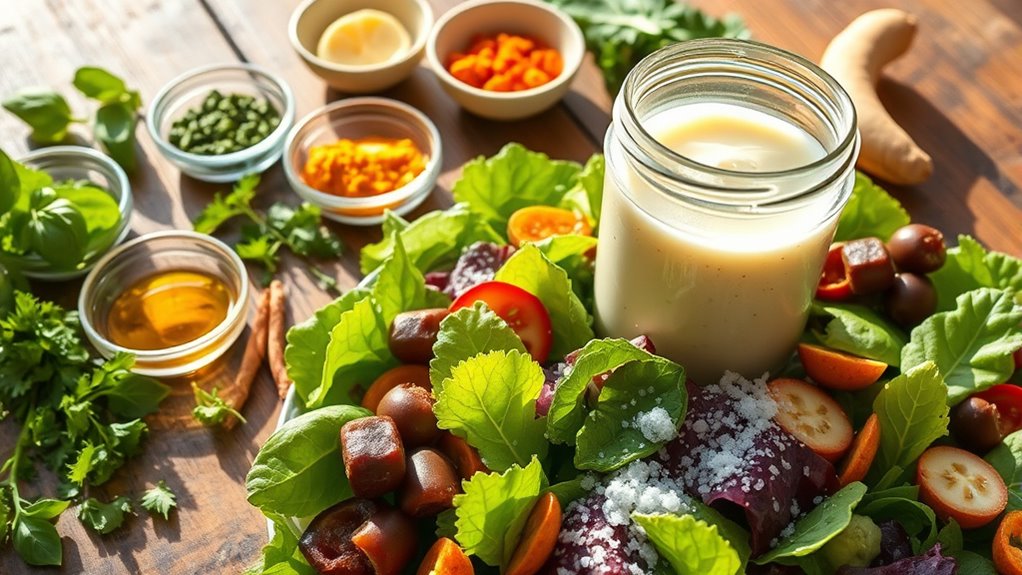
Preparing anti-inflammatory dressings is quick and straightforward. You’ll combine measured ingredients, then whisk or blend until smooth, creating a cohesive emulsion that clings to greens. Start with a base like olive oil and an acid such as lemon juice or vinegar, then add flavor enhancers in small amounts to avoid overpowering the salad dressing. Include anti-inflammatory elements like turmeric, ginger, or garlic powder for depth without heat. For texture, a touch of Dijon or tahini helps stabilize the mix while adding body. Whisk briskly or blend briefly to prevent separation. Taste as you go, adjusting acidity or salt to suit your palate. Store in a jar, refrigerate, and shake before serving to maintain consistency and freshness.
Kitchen tools or Kitchenware Required
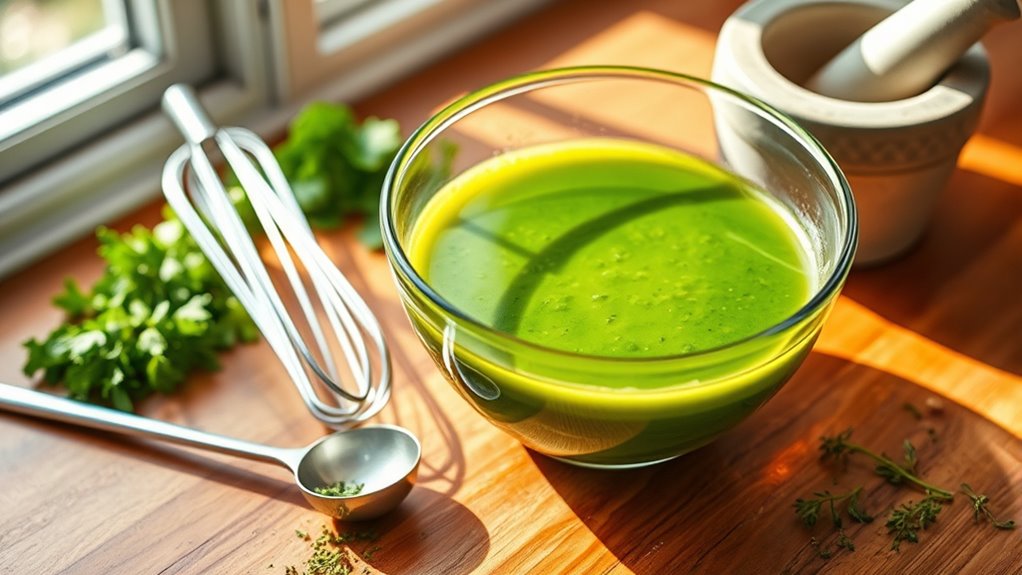
Getting your anti-inflammatory dressings from the pantry to the table is about picking the right tools. You’ll keep prep simple and efficient with a few essentials. A sturdy salad shaker helps you emulsify vinaigrettes without fuss, while measuring spoons guarantee accurate lemon juice, olive oil, and mustard ratios. Choose glass or BPA-free plastic for durability and easy cleaning. A small whisk or fork speeds blending, and a clean jar doubles as storage. Table below highlights basics.
| Tool | Why it helps |
|---|---|
| Salad shakers | Emulsifies, stores, reduces mess |
| Measuring spoons | Precise portions for consistent flavor |
| Whisk or fork | Quick blending, smooth texture |
How to Cook
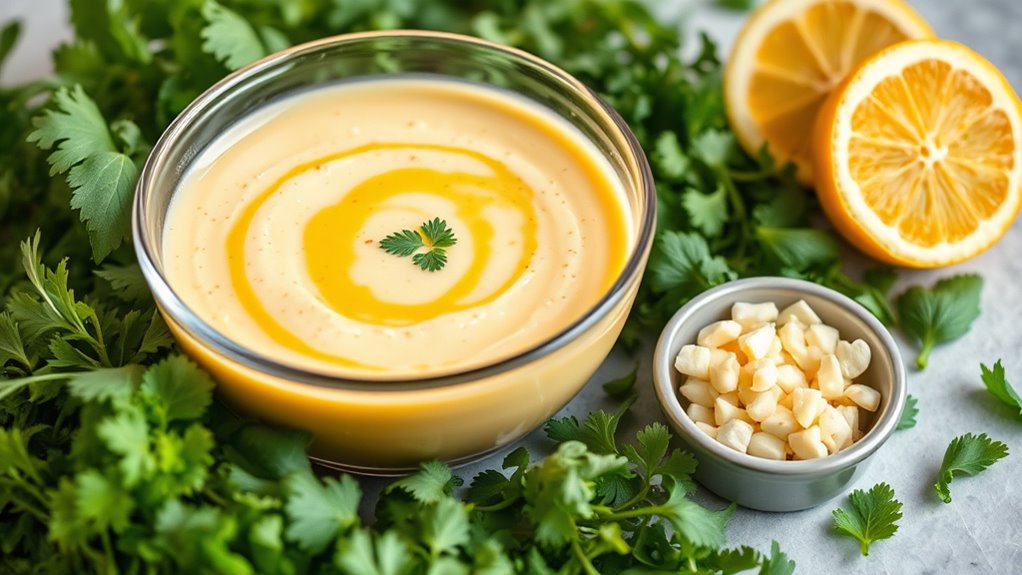
- Start with a quick plan: choose a base for your dressing.
- Add healthy fats such as extra-virgin olive oil or avocado oil for smooth texture.
- Incorporate creamy elements like yogurt or tahini to avoid clumping.
- Balance acidity by adding lemon juice or apple cider vinegar to brighten the flavors.
- Whisk or shake the ingredients until emulsified.
- Taste the dressing and adjust seasonings as needed.
- Enhance flavor profiles with garlic, herbs, mustard, or a dash of honey for gentle sweetness.
- Keep portion sizes deliberate to avoid heaviness.
- Always sample the dressing before adding it to greens to ensure it complements rather than overpowers your ingredients.
How to Serve
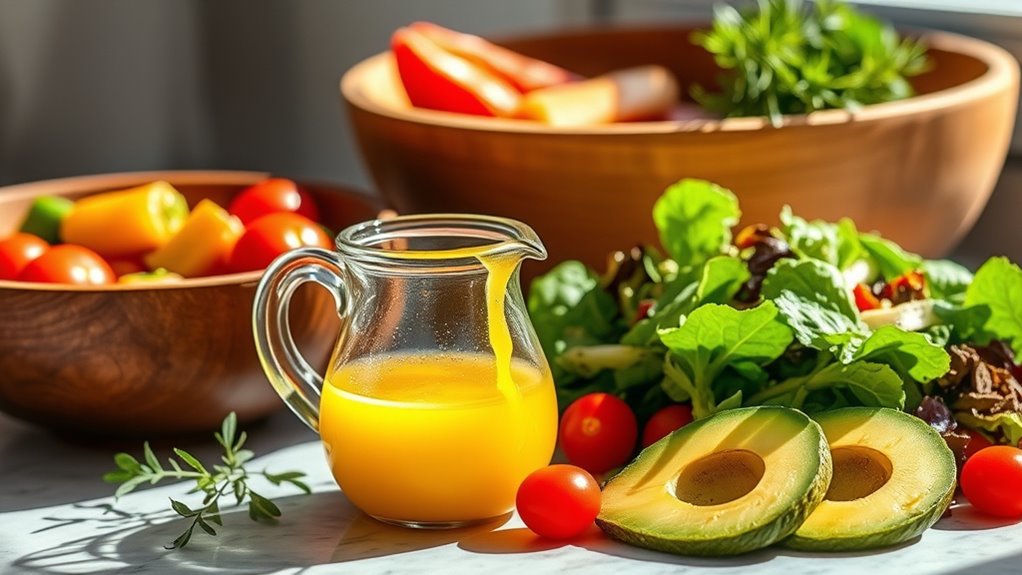
You’ve got a versatile dressing that pairs well with greens, grains, and roasted veggies, so how youserve it matters as much as how you make it. To serve confidently, drizzle just before eating to preserve texture and brightness, or offer a small pitcher for guests to customize portions. Pair the dressing with a crisp, colorful salad base and a protein or grain for balance. Presentation ideas include rotating bowls, layered glassware for grain bowls, or a simple plate with a greens rim and a central dollop of dressing. Use serving suggestions that match the meal’s mood—light and fresh for lunches, richer for dinners. Keep accessibility in mind, ensuring jars are easy to pour and labels clear.
Tips
Here are practical tips to boost flavor and longevity: start with high-quality, extra-virgin olive oil and fresh herbs, since a little goes a long way; taste as you go and adjust acidity with lemon juice or vinegar to brighten the dressing. You’ll boost health benefits by balancing acid, fat, and antioxidants, keeping portions moderate. Choose robust flavor pairings like garlic with Dijon, or herbs like parsley, dill, and oregano to enhance aroma without heavy emulsification. For stability, whisk or shake after resting and store in a cool place; use within a week. Flavor combinations matter—consider citrus with tahini for creaminess, or apple cider vinegar with mustard for zing. Your dressing should feel vibrant, simple, and adaptable to different greens and bowls.
Food Value and Benefit
This anti-inflammatory dressing, made with ingredients like olive oil, turmeric, ginger, and citrus, offers significant nutritional value and health benefits when incorporated into your meals.
Food Value:
- Rich in healthy monounsaturated fats from olive oil
- Contains antioxidants and polyphenols from turmeric, ginger, and citrus
- Provides vitamins such as Vitamin C (from citrus) and Vitamin E (from olive oil)
- Supplies minerals including potassium and manganese
Benefits of Eating This Recipe:
- Supports balanced inflammation and reduces oxidative stress
- Enhances immune function due to antioxidant content
- Promotes heart health by improving cholesterol levels
- Aids digestion and nutrient absorption through healthy fats
- Helps maintain steady energy levels and cognitive clarity
- Increases satiety, contributing to better appetite control and weight management
Incorporating this dressing regularly can contribute to overall well-being by aligning with your body’s natural rhythms and reducing chronic disease risk factors.
Frequently Asked Questions
Where Can I Buy Fresh Anti-Inflammatory Ingredients Locally?
You’ll find fresh, anti-inflammatory staples at local farmers markets and health food co-ops, where bright greens and turmeric glow in sunlight. You can shop local farmers, support seasonal picks, and stock up at health food shops nearby.
Can I Freeze Dressing for Later Use?
Yes, you can freeze dressing for later use. For best quality, follow these freezing tips and dressing storage guidelines: freeze in airtight portions, label with date, thaw slowly in the fridge, and shake or whisk before serving.
Are There Any Allergens to Watch for in These Recipes?
Common allergens vary by recipe, so check labels and ingredients; you’ll spot dairy, nuts, sesame, gluten. If unsure, try substitutions like seeds or coconut. Coincidence grabs attention, and ingredient substitutions keep you empowered with evidence-based choices.
How Long Does an Open Bottle of Dressing Last?
Open dressings typically last about 1–2 months in the fridge once opened. For safety, follow labeled shelf life and storage tips, keep it tightly sealed, and discard if off smells, unusual texture, or separated ingredients persist.
Can Kids Safely Eat These Dressings?
Are these dressings safe for kids? Yes, when ingredients are simple and allergen-free. You can offer kid friendly options and respect their salad preferences, using mild flavors and portion control to support safe, evidence-based choices.
